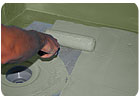
When and why should a waterproofing membrane be used in conjunction with a stone installation? What are some of the specific areas that make sense to use a waterproofing membrane? Some of the obvious use areas are showers, spas, steam rooms, fountains and pools. These are generally considered “constant wet areas” and by building code and design specification, a waterproofing membrane must be used to protect spaces below and adjacent to the stone installation. The Tile Council of North America’s Handbook for Ceramic Tile Installations provides many details that depict the use of a waterproofing membrane in an array of installation methods, including walls, floors, decks, tubs, showers and pools.
In addition to the “constant wet area” applications, a waterproofing membrane can also be used in “intermittent wet area” applications. For instance, the floor areas outside of a tub or shower are great candidates for waterproofing membrane treatments. In many cases, water spills or splashes out onto these areas and if left untreated, the water can migrate through the stone and grout and affect the substrate and the spaces below. Even minor water damage can prove to be very costly to repair.
It is also important to note that many of the waterproofing membranes available today also serve as anti-fracture membranes and help to reduce the potential for hairline shrinkage and “spider web cracks” from telegraphing through to the stone surface.
An excellent use area for these dual functioning membranes is electric radiant heat flooring systems and hydronic floor heating systems. The membrane not only protects the spaces below and around the stone installation and the heating system, but it also helps to reduce the effects of thermal cycling that these types of installations can experience. One of these effects is the expansion and contraction of the stone and the installation system. This movement can cause small hairline cracks to transmit up through the stone finish. The use of these membranes helps to reduce the potential for this occurring.
Other areas that can also be waterproofed include tub decks and surrounds, shower walls and ceilings, countertops, kitchens, exterior facades, building and home entry areas and mud rooms - just to mention a few.
It has been proven that the use of waterproofing membranes within stone installations significantly reduces the potential for mold and mildew in wet areas. Some of today’s waterproofing membranes come equipped with anti-microbial protection, which help to fight off the effects of stain-causing mold and mildew.
Waterproofing membranes also help to keep homes and buildings healthy. They help to prevent the occurrence of poor indoor air quality by protecting against the effects of water damage - including rot, deterioration of building materials, mold and mildew. A few select waterproofing membranes are certified by specific government-endorsed air quality monitoring services.
Generally, waterproofing mem-branes for the stone and tile industry fall into three categories:
1. Liquid latex rubber-applied type
2. Sheet type
3. Reinforced latex-fortified Portland cement type
Within these categories are many membranes, which are thin and load bearing, adding no appreciable thickness to the installation and are fully compatible with latex-fortified Portland cement-based thinset and medium bed mortars. Usually, in most cases, a full latex-fortified mortar bed can also be applied over these waterproofing membranes.
In order to apply the waterproofing membrane, the appropriate substrates should be properly prepared in a similar manner as if a direct-bond, latex-fortified Portland cement thinset mortar were to be applied.
In conclusion, stone can be successfully installed in wet area applications both for interior and even in demanding exterior applications. The use of waterproofing membranes makes sense in many stone applications. The investment that is made in selecting and installing these systems requires that consideration be given to this installation feature. The added cost to include a waterproofing membrane in the stone installation is small when compared to the potential repair or replacement costs that may arise from water and moisture damage.



